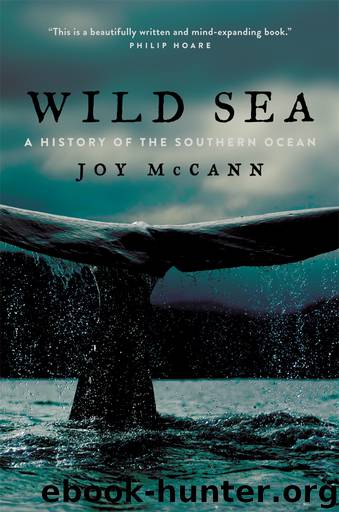Wild Sea by Joy McCann

Author:Joy McCann
Language: eng
Format: epub
Publisher: University of Chicago Press
Published: 2018-05-20T16:00:00+00:00
Once we enter the convergence we may sight our first tabular icebergs setting out on their own voyages, caught in the thrall of the West Wind Drift having calved from Antarctic glaciers and ice shelves. ‘Left to their own course’, one writer optimistically observed in 1974, ‘Antarctic bergs bother no one, drifting well outside normal commercial shipping routes. Once the big bergs calve off the ice shelves, they travel with the circular currents in the southern oceans and eventually melt.’14
Somewhere beyond latitude 55° South we are likely to encounter great expanses of compacted sea ice. Finally, we reach the ice shelves that skirt about 75 per cent of continental Antarctica. In the Weddell and Ross seas, which lie on either side of West Antarctica, the water becomes heavy as salt leaches out of the ice shelves, forming waterfalls below the ocean surface that plunge up to 2 kilometres into the abyss.15 This cold, dense water known as Antarctic Bottom Water can take centuries to flow northward into the global oceans.
Finally, we turn back from Antarctica to the warmer latitudes, mingling with the neighbouring waters in the basins of the Atlantic, Pacific and Indian oceans. The complex layering and movements of warmer and colder waters is part of the slow dance of ice and water, heat and salt as the Southern Ocean converges with the other major oceans of the world, redistributing heat around Earth and influencing its climate. We have traversed the Southern Ocean from north to south, catching glimpses of the extraordinary power and complexity of its movements as it travels on its epic journey around the planet.16
. . .
Ideas about how the Southern Ocean moved around the globe emerged surprisingly early in the history of southern maritime exploration. Mariners were well versed in the lores of surface currents along northern sailing routes by the seventeenth century, but Edmond Halley was the first to record the powerful eastward-flowing circumpolar current of the Southern Hemisphere, making observations from the deck of his British warship, the Paramore, in 1698.17 An astronomer and mathematician with a particular interest in ocean winds and currents, Halley theorised that wind was really just another type of current, created by the warming action of the sun on air and water rather than by the motion of Earth itself, as claimed by earlier philosophers. To demonstrate, he published the world’s first meteorological chart, showing the distribution of prevailing winds over the world’s oceans. As the second astronomer royal at Greenwich at the time, he was also involved in attempts to establish a method of calculating longitude at sea.18 A year later he ventured into the Southern Ocean in an attempt to discover the legendary southern lands, navigating into the ocean between the Strait of Magellan and the Cape of Good Hope and making magnetic and astronomical observations as well as recording weather, currents, flora, fauna and the colour of the sea. He described entering a region of thick fog and experiencing a dramatic drop in temperature, indications
Download
This site does not store any files on its server. We only index and link to content provided by other sites. Please contact the content providers to delete copyright contents if any and email us, we'll remove relevant links or contents immediately.
The Lonely City by Olivia Laing(4750)
Animal Frequency by Melissa Alvarez(4395)
All Creatures Great and Small by James Herriot(4233)
Walking by Henry David Thoreau(3894)
Exit West by Mohsin Hamid(3778)
Origin Story: A Big History of Everything by David Christian(3649)
COSMOS by Carl Sagan(3554)
How to Read Water: Clues and Patterns from Puddles to the Sea (Natural Navigation) by Tristan Gooley(3409)
Hedgerow by John Wright(3277)
The Inner Life of Animals by Peter Wohlleben(3259)
How to Read Nature by Tristan Gooley(3249)
How to Do Nothing by Jenny Odell(3232)
Project Animal Farm: An Accidental Journey into the Secret World of Farming and the Truth About Our Food by Sonia Faruqi(3178)
Origin Story by David Christian(3148)
Water by Ian Miller(3129)
A Forest Journey by John Perlin(3027)
The Plant Messiah by Carlos Magdalena(2883)
A Wilder Time by William E. Glassley(2818)
Forests: A Very Short Introduction by Jaboury Ghazoul(2790)
